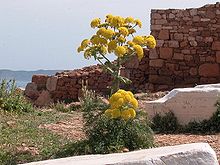
Apiaceae or Umbelliferae is a family of mostly aromatic flowering plants named after the type genus Apium and commonly known as the celery, carrot or parsley family, or simply as umbellifers. It is the 16th-largest family of flowering plants, with more than 3,800 species in about 446 genera, including such well-known and economically important plants as ajwain, angelica, anise, asafoetida, caraway, carrot, celery, chervil, coriander, cumin, dill, fennel, lovage, cow parsley, parsley, parsnip and sea holly, as well as silphium, a plant whose exact identity is unclear and which may be extinct.

In polymer chemistry and materials science, a resin is a solid or highly viscous substance of plant or synthetic origin that is typically convertible into polymers. Resins are usually mixtures of organic compounds. This article focuses mainly on naturally occurring resins.

Pistacia lentiscus is a dioecious evergreen shrub or small tree of the genus Pistacia native to the Mediterranean Basin. It grows up to 4 m (13 ft) tall and is cultivated for its aromatic resin, mainly on the Greek island of Chios, around the Turkish town of Çeşme and northern part of Iraq
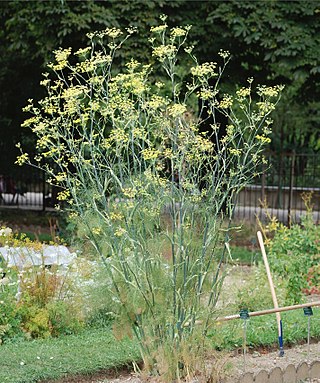
Fennel is a flowering plant species in the carrot family. It is a hardy, perennial herb with yellow flowers and feathery leaves. It is indigenous to the shores of the Mediterranean but has become widely naturalized in many parts of the world, especially on dry soils near the sea coast and on riverbanks.

Asafoetida is the dried latex exuded from the rhizome or tap root of several species of Ferula, perennial herbs of the carrot family. It is produced in Iran, Afghanistan, Central Asia, northern India, and Northwest China (Xinjiang). Different regions have different botanical sources.

Silphium, is an unidentified plant that was used in classical antiquity as a seasoning, perfume, aphrodisiac, and medicine.
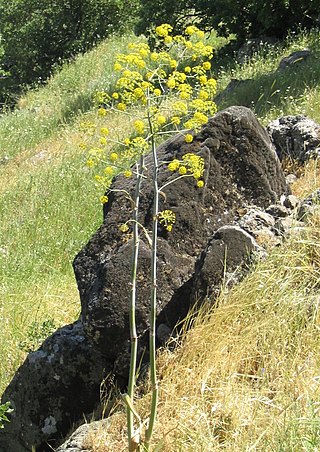
Ferula is a genus of about 220 species of flowering plants in the family Apiaceae, native to the Mediterranean region east to central Asia, mostly growing in arid climates. They are herbaceous perennial plants growing to 1–4 m tall, with stout, hollow, somewhat succulent stems. The leaves are tripinnate or even more finely divided, with a stout basal sheath clasping the stem. The basal sheaths of Ferula oopoda are up to six inches (15 cm) long and form a cup holding about a cup of rainwater, possibly to draw pollinators in an arid land. The flowers are usually yellow, rarely white, produced in large umbels. Many plants of this genus, especially F. communis, are referred to as "giant fennel," although they are not fennel in the strict sense.
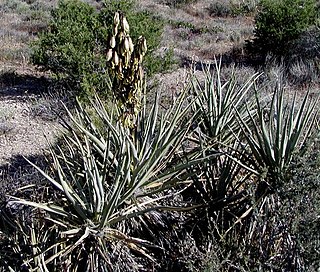
Yucca baccata is a common species of yucca native to the deserts of the southwestern United States and northwestern Mexico, from southeastern California north to Utah, east to western Texas and south to Sonora and Chihuahua. It is also reported in the wild in Colombia.

Tetraclinis is a genus of evergreen coniferous trees in the cypress family Cupressaceae, containing only one species, Tetraclinis articulata, also known as Thuja articulata, sandarac, sandarac tree or Barbary thuja, endemic to the western Mediterranean region.
Ammoniacum or the gumammoniac is a gum-resin exuded from the several perennial herbs in the genus Ferula of the umbel family (Apiaceae). There are three types of ammoniacum: the gums ammoniac of Cyrenaica, of Persia, and of Morocco.
Sumbul, also called sumbal or muskroot, is a drug occasionally employed in European medical practice. It consists of the root of Ferula moschata, known formerly by the synonym Ferula sumbul, a tall umbelliferous plant of the 'giant fennel' genus Ferula found primarily in the north of Bokhara in present-day Uzbekistan, although its range apparently extends into Southeastern Siberia : beyond the Amur river.

Galbanum is an aromatic gum resin and a product of certain umbelliferous Persian plant species in the genus Ferula, chiefly Ferula gummosa and Ferula rubricaulis. Galbanum-yielding plants grow plentifully on the slopes of the mountain ranges of northern Iran. It occurs usually in hard or soft, irregular, more or less translucent and shining lumps, or occasionally in separate tears, of a light-brown, yellowish or greenish-yellow colour. Galbanum has a disagreeable, bitter taste, a peculiar, a somewhat musky odour, and an intense green scent. With a specific gravity of 1.212, it contains about 8% terpenes; about 65% of a resin which contains sulfur; about 20% gum; and a very small quantity of the colorless crystalline substance umbelliferone. It also contains α-pinene, β-pinene, limonene, cadinene, 3-carene, and ocimene.

Papilio hospiton, the Corsican swallowtail, is a species of butterfly in the family Papilionidae. It is found only in Corsica and Sardinia in the Mediterranean Sea.

Kino is a botanical gum produced by various trees and other plants, particularly bloodwood species of eucalypts and Pterocarpus, in reaction to mechanical damage, and which can be tapped by incisions made in the trunk or stalk. Many Eucalyptus, Angophora and Corymbia species are commonly referred to as 'bloodwoods', as the kino usually oozes out a very dark red colour. Kino flow in angiosperms contrasts with resin flow in conifers. The word kino is of Indian origin. In Australia, "red gum" is a term for kino from bloodwood trees and red acaroid resin from Xanthorrhoea spp.

Dracaena cinnabari, the Socotra dragon tree or dragon blood tree, is a dragon tree native to the Socotra archipelago, part of Yemen, located in the Arabian Sea. It is named after the blood-like color of the red sap that the trees produce. It is considered the national tree of Yemen.

Ferula tingitana, the giant Tangier fennel, is a species of the Apiaceae genus Ferula. Despite the name, the plant is not a type of fennel proper, which belongs to another genus (Foeniculum).

Thapsia villosa, commonly known as the villous deadly carrot, is a species of poisonous herbaceous plants in the genus Thapsia. It grows to about 70 to 190 cm in height. It has pinnate hairy leaves with sheath-like petioles. The flowers are yellow in color and borne on compound umbels. They develop into fruits with four wings characteristic of the genus. It is native to southwestern Europe and northwestern Africa surrounding the Mediterranean Sea. The plant was used extensively for traditional medicine since around the 3rd century BC.
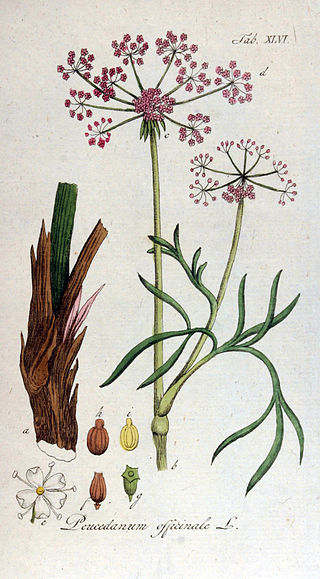
Peucedanum officinale is a herbaceous perennial plant in the family Apiaceae found mainly in Central Europe and Southern Europe. It is also native to the UK, where it has the common names hog's fennel and sulphurweed, but it is a rare plant there, occurring only in certain localities in the counties of Essex and Kent. It was formerly also found near the town of Shoreham-by-Sea in the county of West Sussex, but has long been extinct there.

Opopanax is a genus of plants in the family Apiaceae.

Ferula drudeana is a species of flowering plant in the family Apiaceae, native to the Central Taurus Mountains area of Turkey. It has been proposed as a candidate for the fabled silphium plant of antiquity. It is known from only three locations in Turkey, all sites of longstanding villages.
